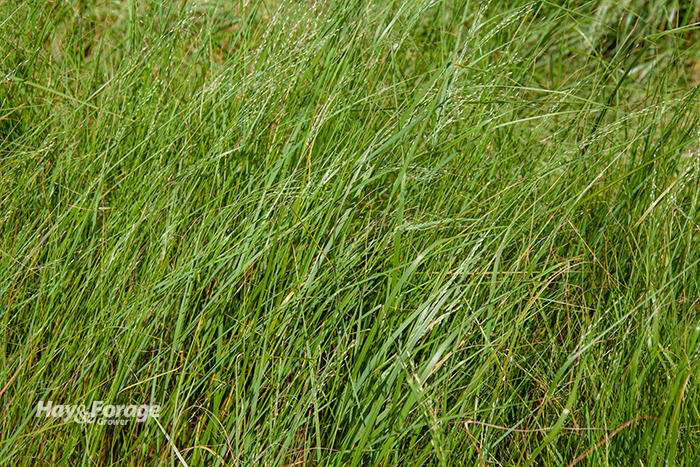
Teffgrass is like the utility player on the baseball roster of forage species. The fast-growing warm-season annual is a good candidate for emergency forage when grazing livestock are short on feed. It’s also suitable for cutting and baling, and its soft texture and nutritional value make it a sought-after horse hay variety.
Allen Arthur is a part-time farmer from Harrison County, Kentucky. He previously grew teffgrass as a cover crop and occasionally baled it to feed beef cattle. Then, he strayed away from the livestock enterprise and devoted his time to solely making hay. He shared his experience as a player in the teffgrass hay market and offered tips to first-time growers at the Alfalfa and Stored Forage Conference held in February in Lexington, Ky.
Arthur explained that teffgrass originated in Ethiopia where it is still grown today, albeit for grain. For this reason, teffgrass was relatively slow to gain traction as a forage after it was introduced to the United States from Africa. Nonetheless, it can yield up to 2 tons per acre in as few as 50 days under optimal growing conditions, which can be a critical resource if perennial pastures winterkill or if the summer slump compromises forage availability.
With that said, seeding teffgrass requires intentionality. “Teff is kind of a booger to get established,” Arthur quipped. Seeds are significantly smaller than many other species, measuring only a millimeter in length and combining for roughly 1.25 million seeds per pound. Therefore, teffgrass requires a 1/8- to 1/4-inch planting depth; seeding it too deep commonly results in a failed attempt at stand establishment.
Arthur rents a Brillion seeder from his local extension office. “That’s a great way to establish teff,” he said. He recommended seeding teffgrass behind a winter cover crop instead of establishing it into straight sod or a prepared seedbed that could allow the tiny seeds to settle too deep. He also contended that teffgrass is relatively low maintenance when it comes to fertilization and encouraged the audience to save their money on added nitrogen.
“It’s not a rocket ship — it’s a four-cylinder,” Arthur said. “If you want to get crazy with fertilizer, find yourself something that will really grow by putting fertilizer on it. Don’t do it with teff.”
Arthur gets two to three cuttings of teffgrass a year, depending on how early he gets seed in the ground. Total production yields between 1.5 and 3 tons per acre. He noted that like many warm-season annuals, there is a short window of opportunity to cut teffgrass at optimal maturity. Forage quality can tank rather quickly, especially as teffgrass enters the reproductive stage.
“If you start seeing seedheads, you probably should have been cutting,” Arthur said. “At boot stage, you better get in there because you’ve got about five days before you start losing quality.”
He added that he maintains at least a 3-inch cutting height, harvesting higher quality hay and leaving behind lower quality stems.
The bad and the ugly
The rest of his presentation was dedicated to discussing the good, the bad, and the ugly of teffgrass, starting with the bad and the ugly. Arthur noted that as the forage matures, it is highly subject to lodging, which is another reason he avoids applying nitrogen to teffgrass stands. Invasive weeds are another issue.
“Foxtail and johnsongrass can be a bear with teff if you don’t get a good, thick stand, or if you have fields where you’re having trouble with foxtail. I would never plant teff in those fields,” he asserted.
The combination of fine leaves and a dense canopy can make teffgrass slow to dry down once it's cut. Although the top layer of forage might appear dry enough to bale, the rest of the windrow could hold excess moisture that would hurt hay quality and storage stability. If producers were to apply hay preservative to forage, teffgrass would fit that bill, Arthur said.
The good side
The first item on Arthur’s list of good teffgrass qualities was hay texture. “This stuff is soft — and I mean soft. You can sleep in it,” he joked. “It doesn’t matter how mature it gets. I think that’s one thing that appeals to people.”
Teffgrass is also highly drought tolerant and has a low concentration of nonstructural carbohydrates. Arthur said this is attractive to horse owners who are looking for low-sugar forage. Therefore, horse owners comprise the majority of his customer base.
The most important attribute of teffgrass, according to Arthur, is its flexibility in different cropping scenarios. For example, it can be established early for a full harvest season or planted in mid- to late summer if it is evident that available grazing acres or hay supplies will be limited.
Teffgrass can also be instrumental in a double-crop system. Arthur suggested seeding it after harvesting winter wheat and baling the straw. “You can have a cutting of winter forage for cow hay and then have a crop of teffgrass to sell for cash hay,” he said. “It’s a great niche market for small square bales because not a lot of people are growing it.”
To see a recording of this presentation and others from the Alfalfa and Stored Forage Conference, please visit the KYForages YouTube Channel.

